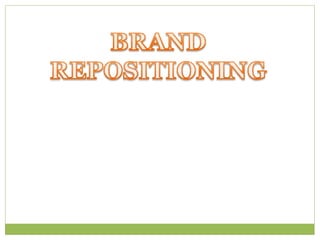
Unit-2 Brand repositioning.pptx
- 2. Repositioning In marketing positioning means the process by which marketers try to create an image or identity in the minds of the target market for its brand, product or organization. Repositioning on the other hand involves changing the identity of the product, relative to the identity of competing products in the collective minds of the target market. Examples: Airtel, Vodafone, Maggie Noodles, etc…
- 3. Reasons for Brand Repositioning Not to beat off competition. Sales increasing but at a slow pace. Create clarity and alignment. Increase value of company. Bringing in new customers.
- 4. Importance of brand repositioning Stronger competitive position. Improved sales. Target market. Aligned to current market needs Potential media attention.
- 5. Types of Repositioning Types Celebrity oriented Segment oriented Symbolism oriented Up-market technology Niche- oriented Change of image- oriented Value oriented
- 6. Value oriented repositioning When a brand offering values is competing against the unorganised sector. When a brand has strongly established a value proposition.
- 7. Segment oriented Repositioning This strategy is useful when a brand wants to change the segment to which it is currently catering some.
- 8. Celebrity oriented Repositioning This strategy is useful when brand uses imagery to strengthen its association and makes an attempt to enter a new segment based on the strength of the imagery.
- 9. Symbolism oriented Repositioning This strategy is useful when a brand with strongly entrenched functional image wants to expand its market using a symbolic positioning without loosing its earlier association. “Guide to a well dressed male” “The complete man”
- 10. Up-market oriented Repositioning This kind of strategy is useful when a down market brand attempts an upward stretch apart from continuing to serve its current customer segments.
- 11. Niche-oriented Repositioning This strategy is useful when a niche brand is interested in expanding its customers base after it has created brand awareness.
- 12. Change of image-oriented Repositioning It is worthwhile to investigate the impact of marketing mix elements on positioning strategies.